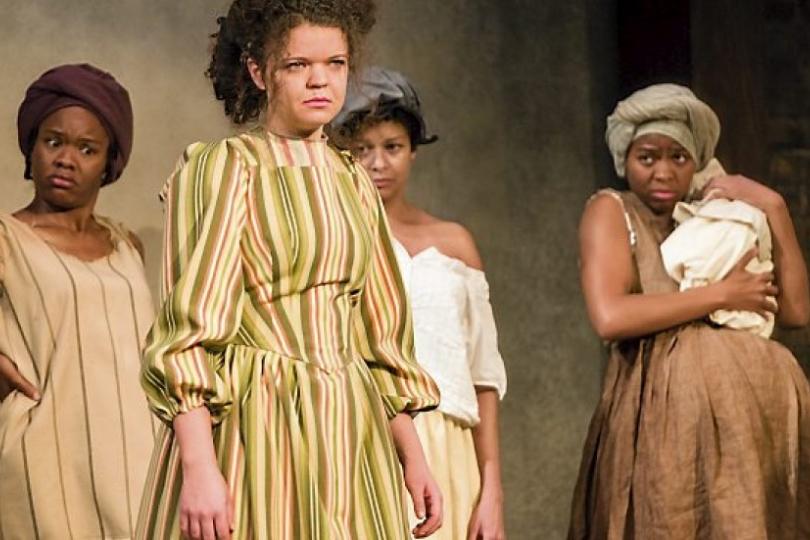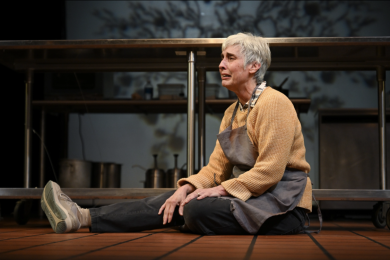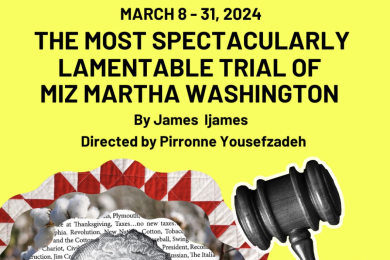The eye of the beholder

The latest much-anticipated piece from playwright Branden Jacobs-Jenkins, An Octoroon bills itself as “a full-blooded investigation of race and cultural politics.” Yet as much as these social justice buzzwords speak to my heart, I frankly struggled to see these elements in the production itself.
Jacob-Jenkins’ An Octoroon restages Dion Boucicault’s 1859 The Octoroon, an antebellum show second only to Uncle Tom’s Cabin in popularity during its time. At the center of this topsy-turvy love quadrangle stands the show’s namesake Zoe, a young woman who is one-eighth Black (“an octoroon”). Given her racial identity and the time period, Zoe is legally forbidden from marrying the white man she loves, but is instead sold to another white man to pay off the Terrebonne Estate’s debt. Cue crying, conniving, and misunderstanding.
Layered on top of Boucicault’s story skirt a few important additions: an actor playing Boucicault, another embodying Branden Jacobs-Jenkins himself, and the ever-present archetype Br’er Rabbit (of Uncle Remus fame). Together these characters comment on Boucicault’s storyline - drunkenly defending casting and makeup choices, abruptly interrupting the plot to explain playwriting conventions to the audience, and silently daring the audience while transforming the set during scene transitions.
Provocative archetypes
Another change: BJJ’s insertion of three Black women, all slaves on the Terrebonne estate. While probably the strongest performers on the stage, who were also saddled with the most comedy and relatability in this production (“You kinda ghetto, Minnie. It’s embarrassing to the community”), each character directly embodies a racist trope of Black women. The young pregnant single mother. The tired but wise “Mammy” figure. The young and sassy woman, a fiery but powerless object of men’s rapacious desires.
Directed by Nataki Garrett, the show begins strong - William Hodgson as playwright BJJ descends stairs off stage-right, strutting boldly in his white briefs. His stoic defiance challenges the audience’s expectations for the production and its timeliness, corroborating his brazen recounts of the therapy sessions that supposedly spawned this play. “Do you think maybe you’re mad at white people?” his therapist asks him. “I am literally surrounded by white people All. The. Time!” BJJ shouts, gesturing to his Minnesotan audience.
Within the first ten minutes of the production, we see a Black actor apply white facial makeup, a white actor apply red facial makeup, and a Latin@ actor apply blackface. Excuses are given. A couple audience members cluck their tongues in disapproval. A high schooler laughs. The rest seem shocked into silence. (That was perhaps the point.)
Yet without a hint of a framework through which to process any of these pieces, the production instead lurches into Boucicault’s world. This adaptation of Boucicault’s piece simply felt too long, too distanced, and too dissonant. The inconsistent renderings of characters as archetypes from the 19th century but also as modern-day figures on the bus (“Those were some cool ass white people”) fell short for me. For me, the performers felt neither like they commented on their characters nor quite successfully satirized the ludicrously racist components of the show. With such layers, I wanted more depth. Honestly, I wanted stronger performances and a more integrated interweaving of Boucicault and BJJ. Instead, I just felt confused and uncomfortable.
Missing the mark
Given the strong start, I wanted BJJ’s character to return sooner, to guide us and provoke us well before Act IV. By the time he finally reappeared, I was so mentally exhausted trying to keep track of the plot twists, names, and layers that I had almost completely checked out of the performance. With such high hopes for these intertwined pieces, especially given the outrage over #AssaultAtSpringValleyHigh and countless other acts of violence against Black communities, I felt dismayed by this haphazard rendering of a really interesting concept. The theater should challenge our history of (continued) injustice, should raise questions about who laughs at what (a hard-learned lesson from Jacob-Jenkins’ stunner Neighbors, also directed by Garrett), and should evoke emotional responses. Unfortunately, my main emotional response here was disappointment and frustration.
When BJJ and Boucicault return after the intermission, the pacing picks up a bit and the piece feels a bit more accessible; yet the production runs 130 minutes, so this feels quite the marathon. Then a curtain screeches across the stage, images of lynchings sap the air out of the theater. Silence again. 30 seconds worth. Sniffling and rustling in the audience. Then the show just moves along. This jarring juxtaposition, to me, felt like a missed opportunity to drive the parallels home. Instead of just moving on, I wanted the production to embrace its connections to the 21st century fight for Black civil rights. I wanted to feel something new, something fresh, something smart. But we just moved on from our silence into more spectacle. (Also the point?)
A beautiful moment of comedic gold from the second half: Minnie consoling fellow slave, Dido, urging her, “You can’t be bringing your work home with you…You are not your job. You gotta take time for you.” Another: Surprising the audience into “feeling something” when the boat explodes. (Twice.)
Highlights include performances by Jasmine Hughes as Minnie, Jamila Anderson as Dido, and Gregory Parks as Br’er Rabbit. Trevor Bowen’s eye for detail beautifully colors this assemblage of characters, placing us at the intersection of the expected and the fantastical. Eric Mayson’s eclectic accompaniment melds classical pieces with otherworldly cacophony, sculpting a fittingly confusing soundscape. Also excellent: Hodgson’s success with Annie Enneking’s fight choreography, battling himself crisply as male leads George Peyton and McClosky.
However, these moments were fleeting and disconnected, so much so that wrestling with this production as a whole still feels overwhelming several days later. For a show I deeply wanted to ponder and digest, I instead self-consciously wonder which pieces I missed or wished were stronger. I love Jacob-Jenkins’ and Garrett’s critique of performance, of violence, and of masks—yet I felt that the messiness of this production obscured key questions and messages. Rather than feeling like the production even tangentially addressed triggering acts that compound with race, I felt like the production let us off too easy. Like it saw the line and decided to step carefully back in silence.
Is the production worth seeing? Certainly. Will it satiate or disappoint? All in the eye of the beholder, friend.




